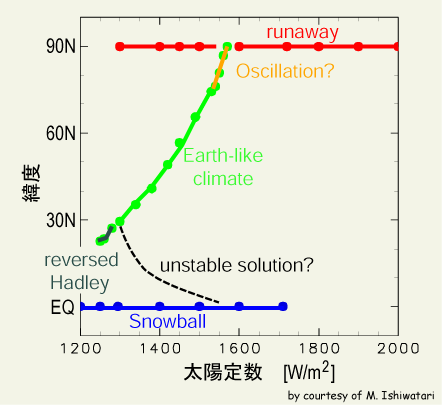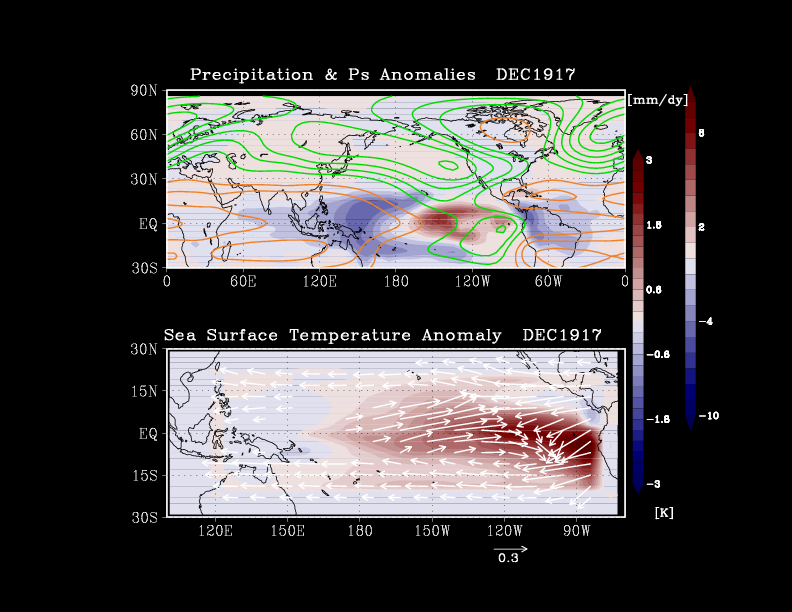What is climate dynamics?
Meteorology, or physical oceanography, is aimed at understanding atmospheric and ocean flows and the average state of, and variation in, temperature distribution. As such, it raises many intriguing questions in and of itself, but what if we were to expand our view to consider the natural environment of the earth's surface layer. The atmosphere and ocean come into contact at the surface of the ocean and, moreover, interaction occurs among differing elements such as land surface conditions and sea ice. Treating all of these interactions as subsystems within a single system, and examining how the interactions between subsystems determine the behavior of the climate as a whole, is the field known as climate system science, or climate dynamics.
Climate dynamics is therefore built on the existing academic disciplines and knowledge of meteorology and physical oceanography. But its interpretation of interaction between subsystems that are not treated as important in those individual fields is very important. Climate dynamics itself is still a young field, so it has not yet established a firm system as found in such fields as meteorology. Therein lies both difficulty and enjoyment. Through systemizing climate dynamics, my hope is to contribute to climate prediction by explaining the mechanism for climate system formation and change.

|
Climate system (Left Figure) Climate condition, which includes that which humans can directly feel, such as temperature and humidity in the ground level, and that which can be seen such as rainfall and snowfall, is made up of various factors that we cannot directly feel. The present climate is formed and maintained by various mediums on the earth's surface, such as atmosphere, oceans, sea ice, soil, vegetation and so forth, which are not independent from one another, but rather part of a single system where they constantly interact. |
To what extent can the current climate, as we know it, continue to exist stably? Could there not be a rapid shift towards a different climate? Answering these types of questions is one of the roles of climate dynamics. Throughout the long history of the planet, climates emerged which varied greatly from the current “balanced” state where the poles are frozen while tropical ocean temperatures reach 30℃. For instance, an extreme case is the “snowball” state where the entire planet is covered by white snow and ice.
The driving force behind the climate system is the radiation from the sun. In addition to solar activity itself, the earth's orbital path and axial tilt vary when viewed on a long time scale exceeding ten thousand years. We can answer the above questions by considering what type of climate emerges when these elements change. However, climate systems are complex systems that include many types of feedbacks. Multiple climatic states can be obtained with the same solar radiation. Furthermore, it has been discovered that even monotonous changes in solar radiation strength bring about rapid transitions from one climate state to another.
|
Multiple Climate Equilibria (Right Figure): The result of changing the solar constant (proportional to solar radiation strength) and seeking the atmospheric equilibrium state in the atmospheric general circulation model. The vertical axis shows ice sheet boundary latitude, and indicates calculation results from various initial conditions. Even if solar radiation is constant, multiple climates are conceivable. Blue indicates the state where the earth's entire surface is covered in ice, red is a “runaway greenhouse state” where temperatures continue to rise, and green indicates a state similar to the current planet where there is partial ice presence. |

|
The well-known El Niño/ La Niña is a representative example of climate system change phenomena. Because El Niño forms due to tropical atmosphere-ocean interaction, investigating its mechanism required cooperation between meteorologists and ocean physicists. Between the 1982-1983 El Niño and the largest El Niño of the twentieth century in 1997-1998, the field of atmosphere-ocean interaction expanded greatly through the accumulation of research utilizing concentrated observation and numerical models. Exceeding the framework of meteorology and physical oceanography in this way is thought to be the first step of climate dynamics. Currently, systems have been established for forecasting the El Niño phenomenon, and its fundamental mechanism has been largely explained. However, on the other hand, new questions continue to arise, the effects of recent warming on El Niño, and the role of interaction of atmosphere-ocean physics and marine ecosystems. I expect that climate dynamics will offer explanations for these questions in the future.



